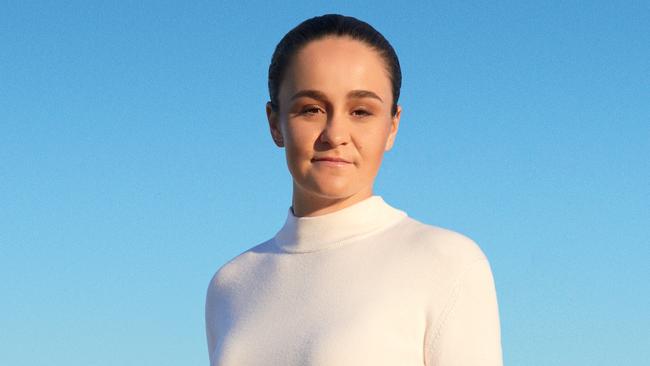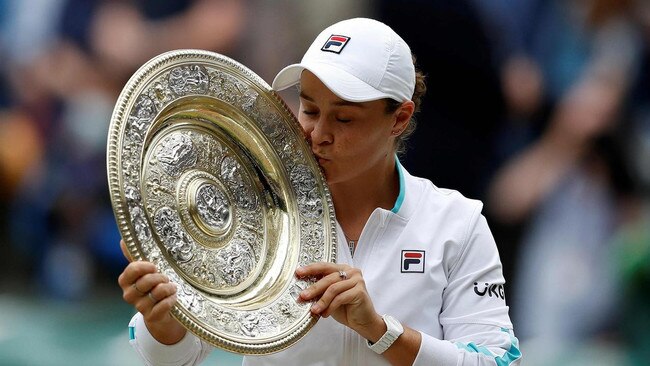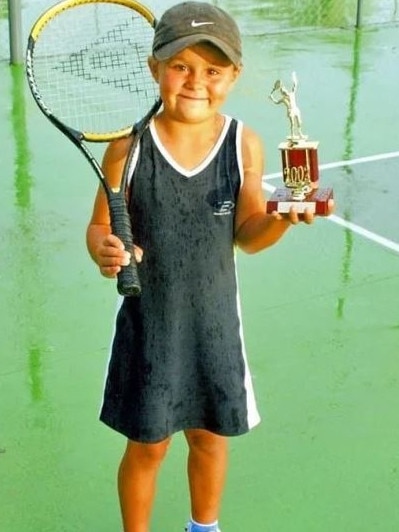How Ash Barty etched her name into history
From her historic Wimbledon win to her engagement to her long-term partner Garry Kissick, world No. 1 and Australian Open title favourite Ash Barty reflects on one epic year.

If you ask Ash Barty to sum up her historic Wimbledon victory in July last year, she will likely reply that the stars simply aligned. It’s a statement that says a lot about the athlete who hails from Ipswich, west of Brisbane. Humble, matter-of-fact and down-to-earth.
While factors leading up to the women’s singles finals at the iconic London lawn club did indeed fall into place, her response is not only simplistic, but far too modest for someone who recently celebrated her 100th week as world number one.
The 2021 tournament was a year like no other. It marked a decade since Barty, 25, had taken out the title as a junior tennis player, but more poignantly, it was 50 years since her mentor and fellow Indigenous athlete Evonne Goolagong Cawley won the women’s singles title at age 19, a feat she miraculously followed up nine years later as a mother.
Barty paid tribute to her hero by playing in a bespoke dress made by her sponsor Fila that featured scalloping in the skirt, an homage to Goolagong Cawley’s own match outfits from the 1970s. But it was also the timing that made the moment so meaningful: the final took place at the end of NAIDOC week, which celebrates the history, culture and achievements of Aboriginal and Torres Strait Islander people. Even more astonishing is that when Barty beat the Czech Republic’s Karolina Pliskova in three sets, she was recovering from a crippling hip injury that forced her out of the French Open less than a month prior. It was a minor miracle she was able to play in the first place.
So it’s little wonder Barty let her emotions flow once the tournament was won. In a post-match interview clutching the famous Venus Rosewater Dish trophy, Barty’s voice caught when asked about the significance of her win.
“I hope I made Evonne proud,” she managed to get out in front of the crowd and world’s media. In another clip that went viral, she broke down and buried her head in the arms of her long-term partner now-fiancé Garry Kissick in a Wimbledon corridor, before stoically wiping away tears.
It’s only now back on home soil in Queensland, many months later, that Barty is taking the time to exhale and process her most challenging – and rewarding – year yet. The devastating injury that sidelined her French Open, followed by her epic Wimbledon victory and fulfilling a lifelong dream to compete at the Olympic Games (where she won a bronze in the mixed doubles), all played out against the unpredictable backdrop of Covid.

Speaking to Vogue a few weeks before what is only the second cover shoot she’s ever done, Barty is only now putting it all into words. “Looking back now, if anyone had said to us in March of 2020 that this is what the next 18 months is going to look like for you and the rest of the world, I think you would have to smile, you’d have to laugh, you’d probably have to cry a bit and think, ‘these are the cards we’ve been dealt.’ In my personal adventure this last year, I feel like we’ve made the most of it,” she opens up.
“Once I was able to let go and accept it was going to be a year unlike any other, it was all about enjoying the adventure. And accepting everything for what it was and trying to find a way to enjoy the hard challenges, knowing there were going to be some really fundamental lessons to be learned.”
“It genuinely was a roller-coaster,” continues Barty. “I think there were probably five or six matches that I felt defined my year all through different stages, all for different reasons, very few of them were about the tennis. It’s impossible to compare it to other years, but certainly from a personal growth perspective, being able to put it all together and come away with probably one of my most successful seasons on tour was incredible.”
Barty was overseas for a six-month stretch in 2021, during which time she won five titles and rounded out her season as number one for the third consecutive year, becoming only the eighth woman in history to do so. Life on tour, she says, was spent in a Covid bubble 90 per cent of the time and consisted of travelling from hotels to tennis courts and back again, regardless of the city. She had more than 70 negative tests over that period, allowing her to play.
“I found that routine a lot easier to adjust to because I was able to play some really good tennis and feel busy, so I think that was a blessing playing a lot of matches earlier,” she reveals. “I became invested in our processes and sometimes when you get on a roll you find some real grit and determination. I felt like I was able to do that really well early on in the season. We had some challenges without a doubt – some tough injuries and moments where, in my mind, I thought it was all going to come crumbling down. But I’m incredibly fortunate to be surrounded by amazing people who care for me as a human first before me as a tennis player.”
Despite her stellar season, Barty returned home quietly in September after a third-round loss in the US Open with a question mark over the last remaining tournaments. She made headlines in announcing her decision not to contest the season-ending WTA Finals in Mexico – a lucrative tournament boasting a $6.7 million winner’s cheque – instead opting to recover from her gruelling year back in the greater Springfield region of Brisbane where she and Kissick reside, with Barty’s parents, two older sisters and their extended family also nearby.

Like many people overseas, Barty admits “the whole process of trying to get back into Australia was really challenging”, and she was forced to wait weeks for a flight home via London.
“I was tossing and turning about what the rest of my season was going to look like and that was a time where I wanted to be home with my family and needed to reset back here [but] I couldn’t get home,” she says. “That was frustrating.”
Hotel quarantine with Kissick, Barty jokes, was just as trying. “It’s a test of your relationship, being with each other for two weeks straight,” she says laughing. “Some days it was good where we had each other and other days you go, ‘Maybe it’s easier to get through this alone.’”
A specialised exercise bike allowed her to keep her fitness up but also “blow off some steam every day, get some endorphins going and kind of make you feel like you’ve achieved something”. Once cleared, Barty says: “It was just about allowing myself to not force a decision, come back, actually reconnect with my family, give them all a hug and celebrate the incredible journey we’ve been on and what an incredible adventure it was … I probably had to give my body time to rest as much physically as emotionally, just to take stock and see where I was at.”
It hardly came as a surprise that she decided to remain in Australia once she was out of quarantine. To say the Barty clan is close is an understatement. The tennis star regularly refers to her success as a collective achievement rather than hers alone and she’s been vocal about the sacrifices both her parents and sisters Sara and Ali made for her when growing up. Family time and rest won over prize money and more international travel.
For the past few months, Barty has been relishing the ordinariness of daily life. Walking her three dogs (two Maltese Shih tzus and an energetic 12-month-old border collie named Origi), picking up her niece Lucy from school, having family barbecues and playing a round of golf against Kissick, a trainee golf professional who Barty met back in 2016.

“I’m enjoying the time now that’s personal to me, reconnecting with my loved ones and almost reconnecting with what life’s all about, and not having the professional side of my life interfering at the moment,” says Barty. “It’s just nice to take stock and train a little bit but certainly prioritise the things that matter most to me.”
In Kissick, Barty has found a kindred spirit, who is content juggling his work at the local Brookwater Golf Club with that of support person for a globetrotting professional athlete. “He’s extremely patient with me, and when we met he didn’t know a lot about tennis,” she reveals. “He’s kind of been thrown in the very deep end in understanding what the tour is like and how much we’re apart … [But] he’s the best person to have around in the sense of switching off from tennis and being able to bring the fun and laughter when we are training and not be so serious all the time … I certainly wouldn’t want to share this journey with anyone else.”
Right now, Barty says: “We lead a pretty quiet life. We’re all very much homebodies.” She’s slightly amused by any increase in public attention, adding: “I’m extremely lucky to get so much support and people wishing me well and congratulating me when I come home, but my local Woolies is still my local Woolies. That won’t change for me. We love the area we live in. I was born here, bred here and wouldn’t be able to live anywhere else.”
“It feels normal, which is really heartwarming, knowing no matter where you go or what you do, home is where the heart is. Once you do get here, I am just the best version of myself again.”
Being the best version of herself brings Barty back to Evonne Goolagong Cawley, a Wiradjuri woman now aged 70, whom Barty, a descendant of the Ngarigo people of south-eastern New South Wales, has looked to over the course of her career for guidance and advice – both as a tennis player and as a high-profile Indigenous sportswoman.
Barty first learned of her own Indigenous heritage on her dad’s side at age six or seven, spurred on by her sisters’ curiosity. “It’s a pretty special thing to learn about when you’re really young. To know that, for us, we’re connected to the land. We’re as connected to Australia as anyone can get,” she says of the experience.
After meeting Goolagong Cawley when Barty was a talented teen playing at the Australian Open junior event, she says they had an “instant connection” and have developed a close relationship ever since. For her part, Goolagong Cawley tells Vogue she knew after watching Barty take on the top American junior (who was four years her senior), “Ash had everything to succeed”.

In late 2014, when Barty was struggling with the sport, it was Goolagong Cawley who urged her to take a break and “go where the lines are”, in reference to fishing. “I was in a pretty bad place and to have that message come through from her was this weight off my shoulders,” recalls Barty. She says she remembers thinking: “This is a person who loves me for me and not whether I win or not.”
Off the court, she was also being guided on how to use her influence for good within the wider Indigenous community. Back in 2011, Goolagong Cawley remembers: “Ash came and hit with our Aboriginal kids at the Goolagong National Development Camp on Rod Laver Arena … My foundation uses tennis as a vehicle to help provide better education and health for Indigenous boys and girls, and Ash asked lots of questions about their lives. As our friendship grew, this side of the foundation became as important to Ash as it is to me.”
Barty, too, remembers that time fondly. “That kind of friendship and that kind of mentorship, for me, has been a game changer,” she says. “We connected through [Evonne’s] Indigenous work and platforms, and being able to see the work she had done after her career is what drew me to her the most.”
In 2018, Barty was named Tennis Australia’s National Indigenous Tennis Ambassador – an ongoing role which sees her inspire more Indigenous kids to get involved in the sport. Trips to regional locations as part of this work have, until now, remained largely out of public view. In addition, Barty works in partnership with the Queensland State Library to help improve opportunities for Indigenous education in remote areas.
She recalls a project from 2019 that provided all 24 Indigenous Knowledge Centres in Queensland with access to computers. It remains an achievement she’s incredibly proud of and served as a catalyst for pursuing further work within this space.

“My dad has worked across a lot of Indigenous communities and in the State Library of Queensland for a long time and has seen how limited resources are, so for me personally, that’s where my biggest connection is and where I want to make a difference,” says Barty.
“I don’t do it for the recognition, that’s not what makes me happy. Each year we continue to grow and help the Knowledge Centres become better places for people to be, to learn and discover what they want in life and to become curious.”
On a personal level, the two women remain close. “She is gifted beyond her peers as a player but works as hard as any of them,” says Goolagong Cawley. “Her open and fun-loving nature is felt by all who follow her on and off the court. There is a joy to her that I recognise and love. She is happy and content but still strives to become an even better human being. In my book, my ‘little sister’ is doing just fine.”
“I’m extremely lucky to have [Evonne] in my corner – as a friend, as a mentor, as someone who has paved the path for our heritage and inspired people to try and be the best version of themselves. It’s incredible that she’s only ever a phone call away,” says Barty, who reveals Goolagong Cawley was also one of the first to message her after her Wimbledon victory.
Adds Barty: “I’m a strong believer in everything happens for a reason and I think [Wimbledon] was an alignment for our culture, for our family and for our heritage. We get to share this moment forever together. It’s pretty remarkable that we’re connected forever, not only through our heritage but through the best place on earth to play tennis … no one can ever take that away from us.”
Barty loves that Goolagong Cawley dared to dream big back when she was playing and it’s something she has also embraced in recent years with the help of mindset coach Ben Crowe. For all her recent months of reflection, she remains a driven and determined athlete with one sole focus heading into 2022: the Australian Open. She’s become increasingly vocal in recent years about her goals and is aiming to win her first grand slam on home soil.

“Each year we set new goals. I’ve set some outrageous dreams to try and reach – and you don’t reach them all – but why not?” asks Barty. “Why not go out there and try and create some really happy memories?
“I’m excited for the Australian summer,” she continues. “To flick the switch and really start training and preparing with my team … [The Australian Open] is absolute chaos, but it’s organised chaos, chaotic happiness, and it just screams energy … I can’t wait to feel that again. Having played much of last year behind closed doors in a sense of not being able to connect with the fans or being able to enjoy it with them, I hope that this year in Australia we have that. Because that’s the very best part.”
While it’s too early to talk of defending her Wimbledon crown, Barty hopes her appearance at the Australian Open will resonate more than ever with younger Australians. She wants to inspire
kids who may be just discovering tennis, as well as those simply wanting to learn what it takes to chase your dreams in life, no matter what they are. “A massive part of being back in Australia now, for me is it reignites my passion to help others and see kids smile when they’re at tennis for the first time or picking up a racquet for the first time,” concludes Barty.
“The summer months in Australia are just incredible for me personally and also in that it lights up my world seeing the opportunity [to inspire] young kids. I genuinely think that’s what I was put on this planet to do, to try and share my stories and help the young all through the nation in discovering what they want … I can’t wait to get out there.”
This article appears in the January issue of Vogue Australia, on sale January 6.

To join the conversation, please log in. Don't have an account? Register
Join the conversation, you are commenting as Logout